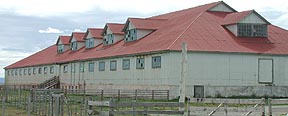The Estancia System: a Distinctive Feature of Southern
Patagonia
 Robert Runyard |
On the pampa (steppe lands) of Southern Patagonia, the individual unit of livestock production is the estancia (ranch) (this system is also used in areas where rainfall is higher). To be cost-effective, given the generally low levels of fertility, each estancia covers a large area. Nowadays, three thousand hectares (about 10 square miles) barely provides subsistence for one family. Historically, company-owned estancias were organized on an industrial model, and were many times larger (as much as 200,000 ha).
In earlier times, the estancias were the only settlements on the pampa; and the large distances made communications difficult. In an era without motorized vehicles, individual travel was on horse-back; winter snow permitting, of course. Large ox-drawn carts took many days to transport wool bales to the coastal ports for export. Sheep were herded overland to the graserías and frigoríficos (meat-processing plants), also located on the coast, finding forage along the route.
These logistical difficulties imposed a high degree of self-sufficiency, and favoured larger-scale operations. The "heart" of a classical estancia comprised a complex of specialized buildings and installations, including sheep pens, dipping baths and shearing shed; stables; stores and barns; wood and metal workshops; kitchen, dining and sleeping quarters for the workers; individual dwellings for the families of the administrative staff; and, set apart, an imposing casa de administración ("big house") for the general manager. Later, the largest operations were also equipped with clinic, recreation facilities and (very occasionally) an elementary school.
The social and geographical isolation was often extreme. This was a man's world (the few women present were mostly wives of the higher-level staff). Distances were "shortened" when, in time, the large companies installed private telephone lines to link their estancias with commercial offices in the towns: these were a great boon for business, and likewise in case of emergency. However, progress did not come to all: many ovejeros (shepherds) were still permanently stationed in remote locations (with horse and dogs) to tend the flocks. Living alone for months on end in puestos (simple huts), their contact with other human beings was scarce. Much later (and even to this day), news from the "outside world" reached them via the daily radio programme "Mensajes para el campo" ("messages for the country").
After the initial "pioneer" period, life in the estancias was certainly bearable, but never easy. The weather, especially the high winds and winter snows, was a constant menace. Water, of course, had to be found on-site. Some basic vegetable crops (potatoes, cabbage, carrots) could be grown locally, to accompany the abundant home-produced mutton. All other supplies had to be brought in at high cost. In particular, the absence of trees on the pampa meant that there was no cheap fuel supply for heating houses and operating machinery. Many buildings were prefabricated using imported materials: roofs were made of corrugated iron, the same material being used for exterior walls.
Public services non-existent. For instance, whenever possible, expectant mothers made the long trip into town some time before the new baby was due. To pursue their education, children had to lodge in town, if possible with relatives: only well-off families had the resources to send their children to boarding school, in Buenos Aires and Santiago, or back in the home-country. Without a resident police force in most cases, law-and-order was perforce a local matter. Entertainment? -- something to look forward to on the next trip to town. In short, self-sufficiency was the day-to-day imperative for people and business alike.
Summing up, the estancia system in Southern Patagonia developed in response to the economic and social challenges of sheep ranching in hostile surroundings. Its basic structure has endured, with certain changes, to the present day. The general level of isolation is lower, although the work of the ovejero apparently continues unchanged. Certainly, the industry is not as prosperous as before: but this is due to low world market prices of wool and mutton, rather than any major inherent flaws. Despite a century of technological advances and social change, the estancia remains the fundamental unit of sheep ranching in the region.